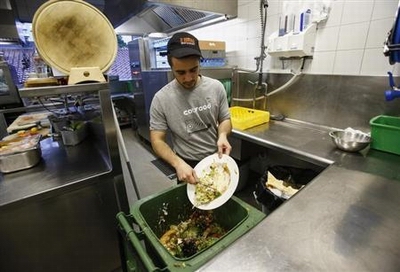
What next? Did you sling that yogurt into the trash? Pour the juice down the sink? You probably congratulated yourself on a lucky escape. After all, who knows what might have happened had you unwittingly consumed a food a few hours past its "sell by" date?
In fact, it's likely you would never have noticed. Food date labels are typically unrelated to food safety. They are simply a manufacturer's suggestions for "peak quality" and a shelf life they set by their own market standards. The dates don't tell you when your food will spoil, nor do they indicate the safety of food.
A new date labels study released this week by the Natural Resources Defense Council and the Harvard Food Law and Policy Clinic reveals that this mass confusion imposes costs on consumers and businesses and leads to a staggering amount of waste. In America, we throw away 40 percent of the food we produce every year. That's nearly half our food — $165 billion dollars' worth — in the garbage, instead of in our stomachs. Nine out of ten of us discard food — and likely are convinced we need to go out and buy more — because of the mistaken belief that the "sell by" date has a food safety implication for ourselves or our family.
It's estimated that 160 billion pounds of food is dumped in the United States annually, in part due to this labeling confusion. That's almost enough wasted food to fill up a football stadium every day. Discarded food is the biggest single contributor to solid waste in landfills. We're throwing away perfectly good food at a time when one in six Americans is considered "food insecure," meaning that they struggle to put food on their tables year-round. Globally, 28 percent of the world's farmland is being used to produce food that is not being eaten. That's an area bigger than China.
This is a terrible waste, not just of the food itself, but of the resources that go into producing that food.
Consumer food waste is a developed-world problem. A recent report by the United Nations Environment Program (UNEP) and the Food and Agriculture Organization (FAO) revealed that 31 to 39 percent of food waste at retail and consumer levels occurs within the middle- and high-income areas of the world, compared to just 4 to 16 percent in developing nations
And the further along the food chain a product is wasted, the worse this becomes for the environment, because production, processing, packaging, transport, storage and cooking are likely to have already taken place.
Wasted food eats up our agricultural land, drinks up our freshwater and pollutes our atmosphere. And in a world with a rapidly-growing population, it also creates the potential for competition and conflict over valuable resources.
UNEP urges a "reduce, reuse, recycle" policy: reducing food waste, wherever possible, at every stage of the supply chain; reusing wasted food by distributing it to the needy, through food banks, for example; and recycling through composting rather than inefficient landfill.
None of this needs to be costly. UNEP has identified areas where significant savings can be made, and new economic opportunities can be grasped, in tackling this ongoing issue.
Meanwhile, the Natural Resources Defense Council is calling for the United States to catch up to the rest of the world in addressing food waste, starting with an overhaul of food labeling policy in the United States.
The date label that is most misinterpreted is the "sell by" date. This date is not intended for the consumer at all, but is a guide from manufacturers to help retailers manage stock rotation. NRDC recommends making "sell-by" dates invisible to consumers.
In their place should be a clear, consistent labeling system that provides useful guidance for consumers, and distinguishes between safety-based and quality-based dates. A standard storage and handling guide, akin to the nutrition information box on food products, would also be helpful.
But the onus must not entirely fall upon producers and retailers. Consumers need to play their part too. When it comes to tackling the $165 billion mountain of food waste that America produces every year, and the wastage globally, everyone needs to step up to the plate.





